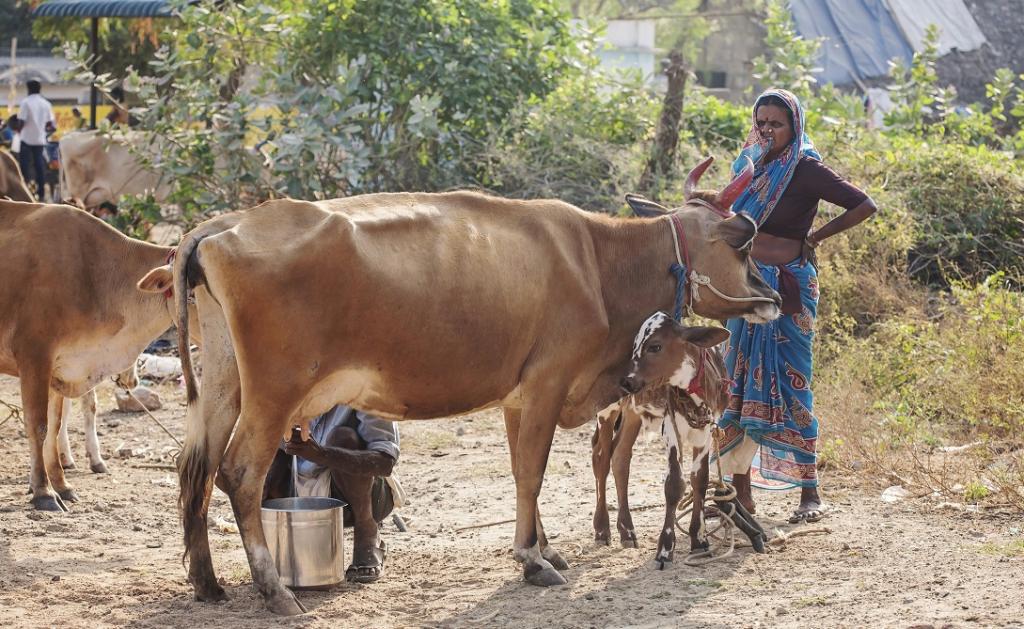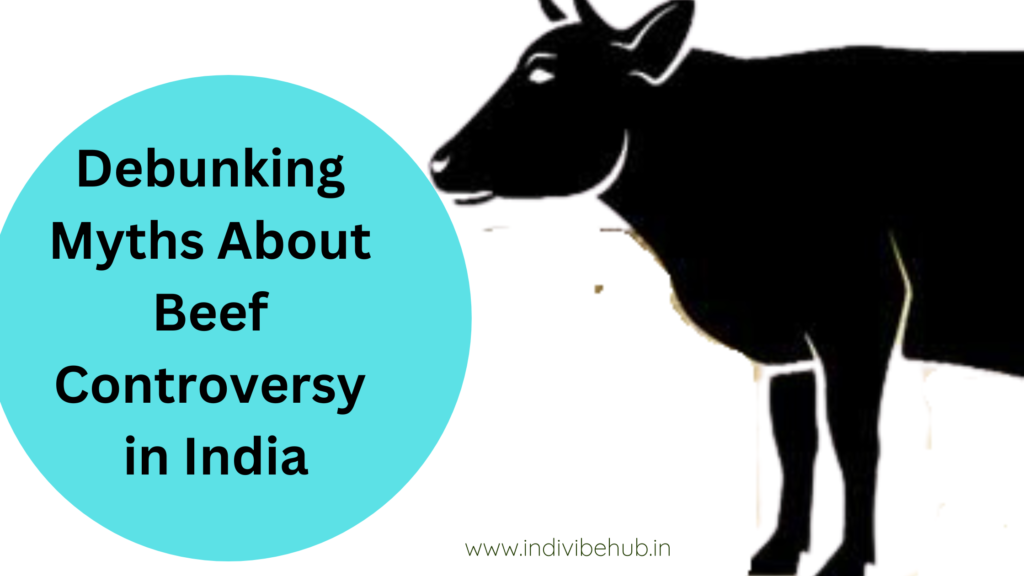Before knowing about the myths of Beef controversy, we need to understand first that what is the beef controversy in India and why it gained highlights in recent times.
As we all knows that India is a country where people of different religions is living. However the majority population of India is of Hindu religion only and Cow is not just an animal for Hindus, it is a sacred animal for Hindus community living in India.
There are some incidents reported in India, which made the beef consumption controversial. For debunking the myths about beef controversy in India, information is required in terms of history of beef consumption in India, cultural and religious importance of the cow in India for Hindus and other community and also the negative and positive aspects of beef consumption in general, so that an informed decision can be made regarding these beef controversies.
Table of Contents
Why Cow is a Sacred Animal for Hindus
In the past, the roots of cow worship can be traced back to ancient times when the agrarian society relied heavily on cattle for agricultural activities. Cows, with their contribution to plowing fields and providing milk, became indispensable to the livelihoods of the people.
In Hindu scriptures such as the Rigveda, the cow is frequently mentioned, symbolizing purity and non-violence. The gentle and nurturing nature of the cow aligns with the core values of Hinduism.
The symbolism of the cow goes beyond its practical uses. In Hinduism, it is often associated with the motherly qualities of nurturing and providing sustenance. The gentle gaze of a cow is seen as a reflection of divine compassion.
Hindu rituals and festivals often involve the presence of cows. From the ritual of “Gopuja” to the celebration of “Govardhan Puja,” these events underscore the spiritual connection between Hindus and cows.
Beyond their religious significance, cows play a crucial role in the economic landscape of Hindu communities. They contribute to agriculture, provide milk, and their dung is used as a valuable resource.

Addressing misconceptions is crucial. The worship of cows in Hinduism is not merely a superstitious practice but rooted in deep cultural, historical, and philosophical foundations. so it is clear that why Hindus are against the frequent beef consumption of the cow.
But is the beef consumption in India is a new concept and If no then why it gained highlights in recent time ?
Historical evolution of Beef Consumption in India:
Debate on beef consumption in ancient times
D.N. Jha’s seminal work, “The Myth of the Holy Cow” (2009), provides a thought-provoking exploration of ancient beliefs. Contrary to popular notions, Jha posits that in ancient times, animals, including cattle, were neither inherently violent nor revered. However, a critical examination reveals a lack of concrete evidence from the Vedas, Upanishads, or any other Hindu scriptures to support these claims. Vedic scholars vehemently accused proponents of such views of intentionally misinterpreting Sanskrit words.
The Grihya Sutras, ancient texts outlining domestic rituals, introduce another layer to the discourse. These texts suggest that those in mourning, post the final rites ceremony, were expected to incorporate beef into their diet. This seemingly contradictory stance challenges conventional perceptions and underscores the complexity of historical narratives.
Journeying back to the Indus Valley Civilization, historical records reveal a prevalent consumption of beef and wild boar. This attests to a diverse culinary landscape that contrasts starkly with contemporary perceptions of Indian vegetarianism.
During the Vedic period (1500–500 BCE), the sacrificial ritual took center stage, encompassing the offering of animals, including cows. The transition from ritualistic offerings to consumption during ceremonies showcases the evolving dynamics of cultural practices.
Marvin Harris injects further complexity into the narrative by highlighting the contradictions within Vedic literature. Some instances suggest the ritual killing and consumption of meat, while others vehemently oppose such practices. This divergence underscores the multifaceted nature of historical perspectives on dietary choices.
Cow status during British Rule
During British rule in India, the adoption of British culinary habits, including beef consumption and whiskey indulgence, became a way for individuals in English-language colleges in Bengal to assimilate into the prevailing culture. In the 1830s, some Hindus deliberately consumed beef, signaling a departure from what they perceived as “irrational Hindu customs.”
Movements for Cow Protection in British India
In the 1870s, the protection of cows gained significance among Hindus due to their sentiment towards these animals. The Namdhari Sikhs initiated the Kuka Revolution in 1870, opposing British rule and striving to safeguard cows from slaughter.
The first Cow Protection Society, known as Gaurakshini Sabha, emerged in Punjab in 1882. By 1893, the sentiment for cow protection had peaked.
Post-Independence Policies on Beef Consumption
Prominent leaders in the independence movement, including Mahatma Gandhi, Bal Gangadhar Tilak, Lala Lajpat Rai, Madan Mohan Malviya, Rajendra Prasad, and Purushottam Das Tandon, staunchly opposed cow slaughter. They advocated for a ban on cattle slaughter after India gained independence from British rule.
Gandhi, while supporting the leather industry, argued that slaughter was unnecessary since cowhide could be obtained from naturally deceased cattle. The British Raj era witnessed communal riots sparked by incidents of cow slaughter.
In 1950, the Central Government advised State Governments against implementing total prohibition on slaughter, highlighting the superior quality and higher value of hides from slaughtered cattle compared to fallen ones.
In a 1958 Supreme Court case, Qureshi contested the constitutionality of slaughter ban laws, arguing that they impeded Muslim religious practices. The Court ruled that neither the Quran nor the Hidaya mandated cow slaughter, allowing alternatives like goats or camels for sacrifice on Bakr-Id.
In 1982, an Indian stamp was issued to celebrate the women working in the diary industries.

Considering the economic impact, there is a shift witnessed In July 1995, where the Government, defending before the Supreme Court, emphasized its support for scientific livestock development, aiming for quality meat production for both export and domestic markets. This aligns with efforts to enhance national wealth and benefit farmers. Notably, grants and loans have been provided for establishing modern slaughterhouses in recent decades, reflecting a commitment to sustainable development.
Legal Framework Surrounding Beef Consumption
Interpreting the Constitution, the Court highlighted citizens’ duty to show compassion to the animal kingdom. Articles 48 and 51-A(g) stress fundamental rights, specifically prohibiting the slaughter of cows and vital cattle.
In supreme court cases spanning 2004 to 2017, India’s Supreme Court addressed animal cruelty during transport and slaughter. The landmark decision in February 2017 mandated the closure of illegal slaughterhouses and the formation of oversight committees.
As India is divided into states, it seems that each states have their own law and mindset on beef consumption. for Example Various states, including Delhi, Gujarat, Haryana, and more, enforce strict bans on cow and progeny slaughter. However Uttarakhand permitting the slaughter of injured cattle with permission, add nuance.
Assam and West Bengal allowing the slaughter of older cows. Calf slaughter rules vary, with Bihar and Rajasthan setting age limits. Maharashtra’s unique definition considers calves below 1 year. These varied regulations reflect the intricate landscape of Indian animal welfare laws.
Role of Beef Industry in Indian Economy
Either Cattle or beef both Industries plays vital role in the Indian economy. As for both industries, India’s position is on high.
In case we talk about the cattle Population, India is carrying the largest cattle population in the world and if we talk about the beef industry then India is fourth largest exporter of the beef after Brazil, China and the EU, in world. In 2023 around 4.4 million metric tons of beef were exported from India.
Environmental Considerations: Carbon Footprint of Beef Production:
Carbon footprint is the calculation of total greenhouse gases emits into the environment during an activity. Study says that 99.48 kg of Co2 is emitted for each one kg production of Beef, which is considered to be the largest carbon footprint for any food production.
So it can be says that environmental cost of beef production is undeniably high. Apart from carbon footprint, Beef production is a notorious water-intensive process. Research indicates that a substantial volume of water is required for livestock rearing and feed cultivation.
The expansion of pasturelands for livestock and feed crops contributes to deforestation and habitat loss. ‘Study reveals the alarming extent of land utilization for beef production, prompting a reevaluation of its impact on biodiversity and ecosystems.
Read Also One stop guide to Indian state delicacies
Nutritional Value of Beef
Beef stands tall as a protein powerhouse, playing a vital role in muscle development and overall health. The high-quality proteins present contribute to a well-rounded diet.
Beyond proteins, beef delivers a myriad of essential nutrients, including zinc, vitamins B12, and selenium, supporting various bodily functions. The heme iron found in beef enhances the body’s ability to absorb iron efficiently, combating iron-deficiency anemia
There are some Health concerns also associated with beef consumption. The presence of saturated fats in beef raises concerns about cardiovascular health. Understanding moderation is key in addressing this potential drawback.
Beef consumption can impact cholesterol levels, necessitating a mindful approach for individuals with cholesterol-related health concerns.
Scientific studies suggest possible links between excessive red meat consumption, including beef, and an increased risk of certain cancers. However, moderation remains pivotal.
Controversies and Violent Acts Related to Beef Consumption in India
Some violent incident happened in several states of India, against those who either involves in beef production business or possessing beef. In 2019, the New York-based human rights organization, reported that from May 2015 to December 2018, over 100 incidents related to beef resulted in 280 injuries and 44 fatalities in India. A significant majority of the victims were identified as Muslims.
Conclusion
Myth 1: Beef Consumption Is Universally Taboo
Reality:
While some communities in India consider cow slaughter taboo due to religious beliefs, it’s crucial to recognize that India is home to various cultures with diverse dietary practices. Beef consumption is prevalent in several states and is considered a staple in certain regional cuisines.
Myth 2: All Hindus Oppose Beef Consumption
Reality:
Hinduism, the major religion in India, encompasses a wide range of beliefs and practices. While some Hindus strictly avoid beef due to religious sentiments, others, especially in certain regions, do consume it. It’s essential to avoid generalizations and understand the diversity within the Hindu community.
Myth 3: Muslims Are the Sole Consumers of Beef
Reality:
The beef controversy is not confined to any particular religious group. Muslims do consume beef, but so do people from various other communities. Stereotyping beef consumption as exclusive to a single religious group oversimplifies the issue and hinders a comprehensive understanding.
Myth 4: Beef Bans Positively Impact the Economy
Reality:
Proponents of beef bans argue that they contribute to economic growth. However, a closer look reveals that the beef industry plays a significant role in providing livelihoods for many, from farmers to meat traders. A blanket ban can have adverse effects on the livelihoods of those involved in the industry.
Myth 5: Beef Production Is the Primary Cause of Environmental Degradation
Reality:
While livestock farming does have environmental impacts, attributing all environmental issues to beef production oversimplifies the complex factors at play. However sustainable farming practices and responsible consumption can mitigate these concerns without necessitating a complete ban on beef.
Myth 6: Beef Consumption Is Illegal Across India
Reality:
Laws regarding beef consumption vary across states in India. While some states have stringent regulations, others permit it under certain conditions. Understanding the legal landscape is crucial to having informed discussions about the issue.
In conclusion, the beef controversy in India is multifaceted, influenced by cultural, religious, economic, environmental, and legal factors. Debunking myths surrounding this issue requires acknowledging its complexity and avoiding sweeping generalizations.




Pingback: Beyond Fashion: Exploring the History and Versatility of South Indian Lungi
Pingback: India is a Hindu country : Truth or Myth ?
Your article helped me a lot, is there any more related content? Thanks!
Thank you for your sharing. I am worried that I lack creative ideas. It is your article that makes me full of hope. Thank you. But, I have a question, can you help me? https://www.binance.com/pt-BR/join?ref=YY80CKRN
Hi, Neat post. There is an issue with your website in web explorer, might test this… IE nonetheless is the market leader and a large element of folks will omit your excellent writing because of this problem.
Your article helped me a lot, is there any more related content? Thanks!